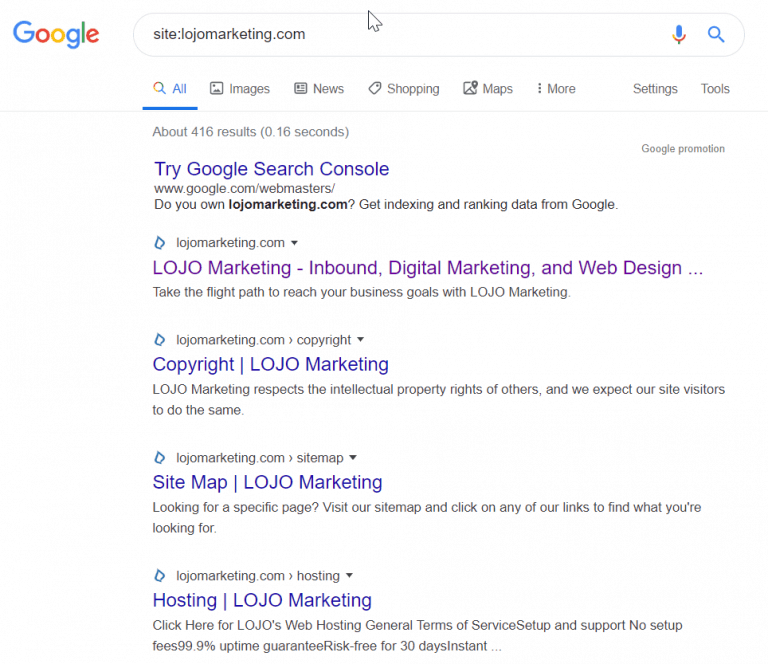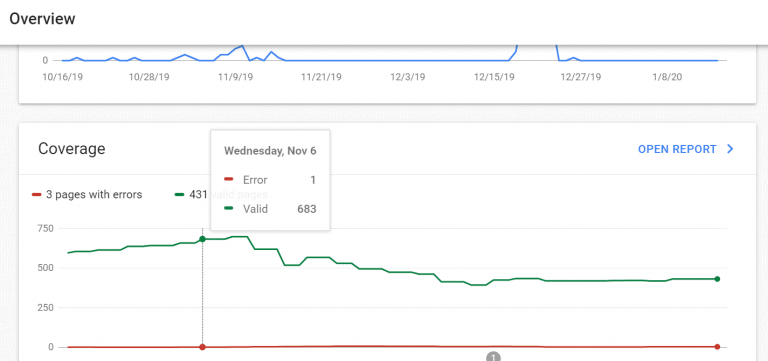TO LEARN IS TO GROW
Learning Center
We do our research and publish our results. Should probably call this the Growing Center.


How Do I Do a Quick Technical SEO Audit For My Site?
There are many aspects to consider when we talk about search engine optimization for your business website. On-page optimization is one (which includes the right type and mix of content), off-page optimization is another (which generally looks at your backlink profile). and then, of course, there’s technical SEO.
A technical SEO audit is like taking a look under the hood of your site to see if it’s running the best way it can. And while they can be time-consuming, they don’t necessarily have to be. In a nutshell, when we’re talking about technical SEO, we should be:
Checking your site security.
Ensuring only ONE version of your site is browseable.
Doing a web crawl of your site.
Determining if your site is being indexed properly by search engines.
Monitoring if you’re actually ranking for your brand name.
Checking if your title tags, H1 tags, subheaders, and meta descriptions are displaying correctly.
Addressing any further errors, warnings, or notices that can impact your SEO.
Eliminating duplicate content as well as beefing up thin content.
Assessing your site’s speed.
Testing the integrity of your internal and external links.
Making sure your analytics is up and running.
Getting your estimated SEO score.
Technical SEO measures your site health, taking note of how your site is being indexed by search engines, how your pages are being displayed on search engine results pages, and how fast your pages load, among other things.
Understandably, technical SEO can be extremely daunting, even for seasoned digital marketing practitioners. Our goal with this article is to show you how we can do an effective website audit without having to spend way too much time but still uncover SEO issues that are potentially holding you back from ranking as well as you should.
What Tools Do I Need for My Technical SEO Audit?
Note that there are already some great paid services out there that just let you type in your URL and you get an on-demand report on how your site is doing in terms of being more search-friendly. Ahrefs Site Explorer, SEMrush Site Audit Tool, and Moz Pro are among some of our favorites.
However, you can pretty much accomplish a quick-and-easy technical SEO audit using the following tools:
Not all of them are essential, but they will help make the process easier.
Check for Big SEO Issues First
So let’s get crackin’.
One of the most basic things you can do is just type in the domain into the browser. By doing so, you can pick up a few key details about the site.
1. Is your site secure?
By typing your URL into the browser window, you should be able to see if your site is secure.
A lot of sites still don’t have an SSL certificate– this allows you to use https:// (either www or non-www) rather than just http:// as there is a slight ranking boost for SSL-enabled sites. Having an active SSL certificate not only keeps your site secure, but it also increases trust.
If you’re getting a “not secure” message just before the URL, then your SSL certificate isn’t active.
If you don’t have one yet, you may want to check with your domain and hosting provider if they can furnish one for free for your domain. There are also services online such as Let’s Encrypt where you can also get a free SSL certificate.
2. Make sure only ONE version of your site is browseable
Step back for a minute and think of all the ways someone can type in your website address into a browser or create a link for it.
http://yourdomain.com
http://www.yourdomain.com
https://yourdomain.com
https://www.yourdomain.com
Only ONE of these should be accessible in a browser. The rest should be directed via a 301 to the canonical version.
Just type these permutations of your URL into the search window to see if they redirect just fine.
This might not be an issue in most cases, but there are sites that do have redirection issues for http to https. Or www to a non-www version.
If you do find issues relating to your URL’s redirection, fix these immediately before moving on.
3. Start a website crawl

Let’s do an initial website crawl next, using a service like Screaming Frog or DeepCrawl (if you’re OK with a paid service) or Beam Us Up (which is for free).
An SEO crawling service will index your site in the same way a search engine (such as Google) would. It will send out little crawlers into your site and give you some useful information on the structure and current SEO setup.
Most of the time, you can just leave the settings as is and run the service. It’s going to take a bit of time, but in the end, you should be able to generate a report that you can review as a PDF or an excel file.
4. Check Google for indexation issues

Check your site is properly indexed by using the Google Search Console service. You can also search in Google using the site: search operator.
site:yoursite.com
This will also tell you how many pages Google has indexed on your site. In this case, you can see that Google has indexed 416 results from our site, lojomarketing.com. While it might not always be as accurate as Search Console, it still makes for a fairly reliable test.
If you’re not seeing any pages indexed, then it means the pages on your site are not indexed, and it means you’re not getting organic traffic whatsoever.
This can be caused by a number of things, but the usual culprit is a rogue x‑robots-tag HTTP header.
If you have this issue, you may need to dig into your site’s File Manager and access your header.php, .htaccess, or server access file.
Check to see if your website crawl’s number of discovered pages matches the number of pages indexed by Google. A discrepancy may mean your pages may be incorrectly configured as “noindex” pages, or perhaps you have broken pages, redirects, or that Google might be indexing elements of a single page as separate pages.
Clean up your index by removing broken pages or reconfiguring pages as needed.

5. Quickly check that you rank for your brand name
Go to Google and search for your brand name. Your site’s homepage should be the very first result on the search engine results.
If your site isn’t on position one, it might mean that:
Your site is totally new
Your brand name might be a generic phrase (and folks don’t want to see your website when searching for that specific term)
Google thinks another site is a more appropriate result for your brand name term.
If you find your site a lot further down the SERPs than you’d like, the best course of action is to do some brand building and link building. For starters, this means you need to:
build some strong, branded links
run a PR campaign, specifically for the purpose of getting mentioned and linked-to from big well-known websites
build citations on business directories
make sure your site has a Google My Business listing
ensure that your site has a presence on all the major (and relevant) social networks
Slow and steady wins the race. Keep at it, and you should slowly climb up the ranks.

If for some reason you’re nowhere to be found in the search engine results, and you’ve already ruled out indexation issues, then this might be symptomatic of even bigger problems, such as a heavy algorithmic penalty or a manual penalty from Google.
Google Search Console should be able to let you know if your site has been hit with such a penalty.
Looking for Other Easy-to-Fix Issues Under the Hood
Next up, we’ll be running a few extra tests to address some more search- or index-related issues.
Many of these items do tie in or overlap with on-page optimization, but for now, we’ll be focusing on spotting potential trouble areas so you can work on them and fix them right away.
6. Manually perform some BASIC on-page SEO checks
Let’s start by checking a few on-page fundamentals.
Figure out the most important pages on your site. You would have seen these on the SERP when you checked how Google indexed your site, or with the report from the initial web crawl earlier.
These most important pages are those that bring in the most organic search traffic for you– in effect, your most popular pages.
In a browser, right-click and view the page source. You’ll want to make sure that any particular page you’re checking:
Has a well-crafted, clickable title tag.
Has a custom meta description– one optimized specifically for getting the most click-throughs.
Has only one instance of the H1 tag.
Has subheaders (H2, H3, H4, etc.) that are being used correctly.
Multiple headers or improperly used headers can be quite distracting and confusing for your visitors. So you’ll want to fix these issues up as soon as you’ve found them.
Go through your list of important pages and do this manual check.
Note that while the meta description by itself does not directly influence your ranking, a well-written and well-optimized meta description can get more folks to click on your page– and having higher CTR’s (click-through rates) helps bump up your Google rankings.
H1 tags are an important on-page ranking factor as well. You should have a single, unique, descriptive H1 tag on each page. Your H1 tag should not only communicate the page’s primary purpose, but it should also include one or two highly relevant keywords as well.
Subheaders are used to help break down the page into more easily skimmable parts, and these should be used to showcase your secondary keywords/phrases.

7. Address more on-page issues
By now the site audit you’ve done should be complete. Generate a report either as a PDF or an excel file, and have a look at the list of all the on-page issues found during the crawl.
Generally, fix any Errors first. Then move on to any other Warnings or Notices.
8. Check for duplicate content and thin content
If you have too much copied-and-pasted content, you might get heavily penalized by Google Panda for having lots of low-quality pages.
For this purpose, we use Copyscape. You may use it for free but it does have some limitations. But if you want a more thorough search for duplicate content across your site, pricing starts at 3 cents per search.

Usually, we’re looking for blogs who may have copied and pasted entire posts and published them on their own sites. Google might get confused as to who is the real author of a particular piece of content, causing the wrong version to rank.
Thin content is another common issue. We’re talking about pages that hardly provide any value– meaning they don’t answer any questions, or offer any substantial level of help or assistance somehow– and so struggle to get any substantial rankings as well.
Sites like Web Page Word Counter allow you to check for thin content.
Usually, a result of anything under 200 words is indicative of thin content. In cases like these, you can fix these pages by putting in more genuinely helpful content or deleting redundant pages.

9. Assessing your site's page speed
The next thing to do is to check that your site (as well as individual pages within) load fast enough.
You could have high-quality content, but if your site and pages are weighed down by too much bloated code or extraneous functions you don’t really need, then it can load slowly, turning off your readers.
Site speed is indeed an important ranking factor. This is particularly true on a mobile phone where your customers don’t like waiting around. The longer a page loads, the higher the probability of your customer bouncing out of there in frustration.

Simply put: a fast-loading site just means a better user experience overall. Nobody has the patience anymore for a slow-loading site.
Useful tools to assess your site’s speed when it comes to loading pages include:
You’ll want to run tests on your most important pages first, just to see how quickly they load. Take note of the errors and warnings and address these right away.
Next Steps
The following are just a few extra tests thrown in for good measure.
10. Make sure your analytics are in order
You’ll want to check if your analytics service (usually, it’s Google Analytics) is reporting live metric data.
If it isn’t, something might be wrong with your existing installation, so that needs to be addressed right away.
If you’re using Google Analytics, you want the tracker code to be placed above the header of each web page.
Once you have Google Analytics up and running, compare the metric data to your earlier search results when you did a “site:yoursite.com” search. The number of pages showing in your metric data should be more or less similar to your “site:yoursite.com” search.
If not, then it means for some reason, your pages aren’t properly processing crawl requests (and therefore need to be fixed).
11. Manage your internal and external links
Links help Google better analyze your site, giving it more context (by way of your external links, or links pointing to external sources) and by determining a clearer content hierarchy (by way of internal links).
Sites with clearer, more organized, more logical hierarchies tend to have better SEO rankings.
Often times, pages on your site might be deleted or moved, which can result in broken links throughout your website.
Using a tool like Xenu Sleuth or Integrity (for Mac users) allows you to identify broken links on your site. They’re both easy to use and fairly intuitive.

You can view results by link, page, status, etc. to help you get a better look at which pages might need fixing right away, especially those with a “404 not found” label, as these can negatively impact your SEO.
12. Get your current estimated SEO score
For this item, we’re using SEO SiteCheckup. You can test one website a day under the free plan, but it should be enough to tell you what you need to know about fixing your site’s SEO issues.

Don’t forget to email a copy of the report to yourself or download a copy as a PDF file for review.
Specifically, SEO SiteCheckup will help you:
Identify your most commonly-used keywords.
Check whether sitemap and robots.txt are available for your site.
Show you any broken links your page has.
Reveal coding errors (e.g., JavaScript, CSS, HTML, etc.).
Let you know if your site is connecting to social media profiles.
Know if your site is doing a good job at compressing and caching data.
Figure out if you have any malware or some other phishing activity going on.
See how your site shows up on smartphones and other mobile devices.
A Final Word About Technical SEO Audits
Regular technical SEO audits are important in that they evaluate your website’s performance when it comes to search engine rankings.
SEO, as we have pointed out, is constantly changing. Search engine algorithms, best practices, market trends, and competitors are always evolving. This means your website has to be up-to-date as well, and a technical SEO audit helps you accomplish just that.
You can get one done quickly to assess if you have any glaring SEO problems to address right away.
Check if your SSL certificate is active.
Run a check to make sure only ONE version of your site is browseable.
Do a web crawl with services like Screaming Frog, DeepCrawl, or Beam Us Up.
Check if Google is properly indexing your site.
Quickly see if you’re actually ranking for your brand name.
Manually check your title tags, H1 tags, subheaders, and meta descriptions.
Address any errors, warnings, or notices from your earlier web crawl.
Eliminate duplicate content with Copyscape.
Assess your site’s speed with a service like Pingdom, GTMetrix, or Google’s PageSpeed Insights.
Make sure your Google Analytics is up and running.
Have a look at your internal and external links using either Xenu Sleuth or Integrity.
Get your estimated SEO score using SEO SiteChecker.
Think of your technical SEO audit as a routine website checkup. Monitor your website’s health and performance regularly, and notice your SEO rankings climb slowly but steadily, bringing you in lots more much-needed organic traffic.
Growing Businesses Since 2008
We have helped hundreds of businesses just like yours. Working for or along-side of business owner, managers, staff, or even board of directors, LOJO is ready to be an asset to your business.
Our team has been curated through the years for individual skills, personalities, and capabilities. Our clients put their trust in us to help them grow. We are here to do just that.



Growing Businesses Since 2008
We have helped hundreds of businesses just like yours. Working for or along-side of business owner, managers, staff, or even board of directors, LOJO is ready to be an asset to your business.
Our team has been curated through the years for individual skills, personalities, and capabilities. Our clients put their trust in us to help them grow. We are here to do just that.




Matthew Rogers, President
iProspect Check
After spending several months reviewing multiple proposals from several different companies we engaged LOJO to develop a new website that represents our company effectively. We worked initially with Stephen Platte who helped create the scope of the project. Stephen was knowledgeable and always followed up with me on time and as promised.
He "closed the deal" for LOJO with his professionalism, service orientation and easy going approach. Once we signed the contract we were introduced to Jay Kelly who would be the creative lead for LOJO. This was the most challenging part of the project for my company, as there was no shortage of ideas from our side. Jay managed the project flawlessly, and once we had all agreed to the design, Jay introduced us to Eric.
Eric Lay is one of the founders of LOJO. Eric took the design we had developed and brought it to life. We delivered content as quickly as he requested it. Eric kept the project on task and we responded by exceeding every deadline for content. In turn, once provided, literally not a day went by that Eric didn't add the content and take the next step. In just a few weeks we launched our new website. Eric is a pleasure to work with.
His positive attitude and consultative approach really enhanced the experience and made a big difference for us in the outcome of our project. We would welcome you to visit our website to take a look at the quality work of LOJO. We are very pleased with LOJO and look forward to working with them in the future as we pursue an aggressive SEO strategy."
After spending several months reviewing multiple proposals from several different companies we engaged LOJO to develop a new website that represents our company effectively. We worked initially with Stephen Platte who helped create the scope of the project. Stephen was knowledgeable and always followed up with me on time and as promised.
He "closed the deal" for LOJO with his professionalism, service orientation and easy going approach. Once we signed the contract we were introduced to Jay Kelly who would be the creative lead for LOJO. This was the most challenging part of the project for my company, as there was no shortage of ideas from our side. Jay managed the project flawlessly, and once we had all agreed to the design, Jay introduced us to Eric.
Eric Lay is one of the founders of LOJO. Eric took the design we had developed and brought it to life. We delivered content as quickly as he requested it. Eric kept the project on task and we responded by exceeding every deadline for content. In turn, once provided, literally not a day went by that Eric didn't add the content and take the next step. In just a few weeks we launched our new website. Eric is a pleasure to work with.
His positive attitude and consultative approach really enhanced the experience and made a big difference for us in the outcome of our project. We would welcome you to visit our website to take a look at the quality work of LOJO. We are very pleased with LOJO and look forward to working with them in the future as we pursue an aggressive SEO strategy."

Matthew Rogers, President
iProspect Check
The team at LOJO were wonderful to work with. They are well organized and very patient as we worked through our marketing strategy and developed a well thought out and clear action plan at a reasonable price. We will definitely be back for our future campaign needs."

Jon Crosby, Founder
Dazil

